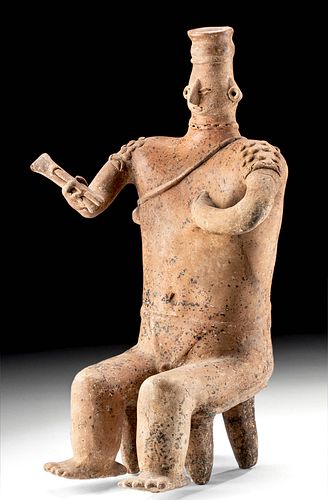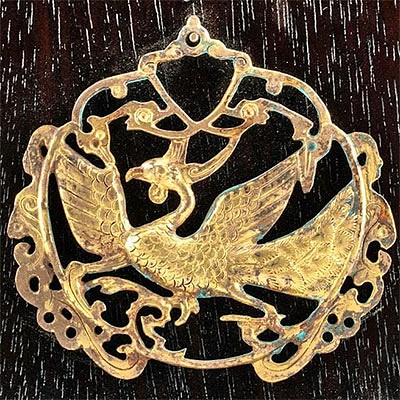Colima Coahuayana Valley Terracotta Seated Warrior
Lot 211
About Seller
Artemis Fine Arts
686 S Taylor Ave, Ste 106
Louisville, CO 80027
United States
Selling antiquities, ancient and ethnographic art online since 1993, Artemis Gallery specializes in Classical Antiquities (Egyptian, Greek, Roman, Near Eastern), Asian, Pre-Columbian, African / Tribal / Oceanographic art. Our extensive inventory includes pottery, stone, metal, wood, glass and textil...Read more
Estimate:
$8,000 - $10,000
Absentee vs Live bid
Two ways to bid:
- Leave a max absentee bid and the platform will bid on your behalf up to your maximum bid during the live auction.
- Bid live during the auction and your bids will be submitted real-time to the auctioneer.
Bid Increments
| Price | Bid Increment |
|---|---|
| $0 | $25 |
| $300 | $50 |
| $1,000 | $100 |
| $2,000 | $250 |
| $5,000 | $500 |
| $10,000 | $1,000 |
| $20,000 | $2,500 |
| $50,000 | $5,000 |
| $100,000 | $10,000 |
| $200,000 | $20,000 |
About Auction
By Artemis Fine Arts
Jun 17, 2021
Set Reminder
2021-06-17 10:00:00
2021-06-17 10:00:00
America/New_York
Bidsquare
Bidsquare : Ancient & Ethnographic Art Through The Ages
https://www.bidsquare.com/auctions/artemis-gallery/ancient-ethnographic-art-through-the-ages-7094
Ancient art from Egypt, Greece, Italy and the Near East, as well as Asian, Fossils, Pre-Columbian, Native American, African / Tribal / Oceanic, Fine art, and much more! All categories, all price ranges... all legally acquired and guaranteed to be as described or your money back. Artemis Fine Arts info@artemisgallery.com
Ancient art from Egypt, Greece, Italy and the Near East, as well as Asian, Fossils, Pre-Columbian, Native American, African / Tribal / Oceanic, Fine art, and much more! All categories, all price ranges... all legally acquired and guaranteed to be as described or your money back. Artemis Fine Arts info@artemisgallery.com
- Lot Description
Pre-Columbian, West Mexico, Colima, Coahuayana Valley type, Protoclassic Period, ca. 100 BCE to 250 CE. A magnificent warrior figure of a sizable form that is hand-built from pottery and exhibits highly burnished surfaces accentuated with orange-red pigment. The regal man sits with bent legs atop an integral, four-legged stool, wears a simple loincloth around his waist, and presents with a dignified, upright posture. In his right hand he holds a double-ended hand axe with a narrow tubular instrument on top and bends his left arm to place his hand atop his slightly concave chest. A slender strap is draped atop his left clavicle, and his shoulders are adorned with zigzagging bangles as well as dozens of petite scarification nodules. Impressed eyes, a tab-shaped nose, spool-adorned ears, and puffy lips create the stylized visage, and the tiered headdress doubles as the figure's cylindrical opening. Size: 9.2" W x 16.2" H (23.4 cm x 41.1 cm)
Clay figures like this one are the only remains that we have today of a sophisticated and unique culture in West Mexico - they made no above-ground monuments or sculptures, at least that we know of, which is in strong contrast to developments elsewhere in ancient Mesoamerica. Instead, their tombs were their lasting works of art: skeletons arrayed radially with their feet positioned inward, and clay offerings, like this one, placed alongside the walls facing inward, near the skulls. A large effigy like this one most likely would have flanked the entrance to a tomb in a way that archaeologists have interpreted as guarding. Some scholars have interpreted these dynamic sculptures of the living as a strong contrast to the skeletal remains whose space they shared, as if they mediated between the living and the dead.
Cf. Kan, Michael, Clement Meighan, and H.B. Nicholson. "Sculpture of Ancient West Mexico: Nayarit, Jalisco, Colima | A Catalogue of the Proctor Stafford Collection at the Los Angeles County Museum of Art." University of New Mexico Press, Albuquerque, 1989, p. 139, fig. 127 and p. 142, fig. 132.
Provenance: private New York, USA collection, acquired around 1966
All items legal to buy/sell under U.S. Statute covering cultural patrimony Code 2600, CHAPTER 14, and are guaranteed to be as described or your money back.
A Certificate of Authenticity will accompany all winning bids.
We ship worldwide and handle all shipping in-house for your convenience.
#159215Repaired from several large pieces, with resurfacing and overpainting along break lines. Chips and a couple of fissures along right wrist and chest, with light pitting and encrustations, and minor fading to original pigment. Great preservation to overall form and remains of original pigment.Condition
- Shipping Info
-
All shipping is handled in-house for your convenience. Your invoice from Artemis Gallery will include shipping calculation instructions. If in doubt, please inquire BEFORE bidding for estimated shipping costs for individual items.
-
- Buyer's Premium



 EUR
EUR CAD
CAD AUD
AUD GBP
GBP MXN
MXN HKD
HKD CNY
CNY MYR
MYR SEK
SEK SGD
SGD CHF
CHF THB
THB















